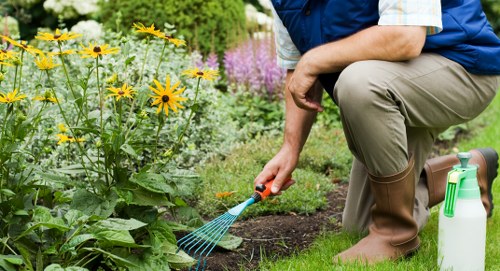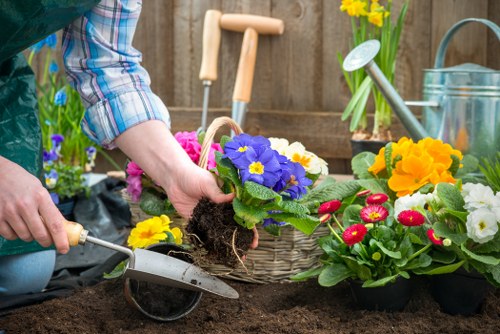Enhancing Your Garden: The Role of Fence Installation in Landscape Gardening
Introduction to Landscape Gardening and Fencing

Landscape gardening is an art that transforms outdoor spaces into beautiful, functional areas. A crucial element in this transformation is the installation of garden fences. Fences not only provide **security and privacy** but also serve as a design feature that can enhance the overall aesthetic of your garden.
Integrating fencing into your landscape gardening plan requires careful consideration of various factors, including material, design, and placement. This ensures that the fence complements the natural elements of your garden while fulfilling its practical purposes.
In this article, we will explore the different aspects of landscape gardening in garden fence installation, offering insights and tips to help you create a harmonious and visually appealing outdoor space.
Choosing the Right Fence Material

The first step in fence installation is selecting the appropriate material that aligns with your garden's design and purpose. Popular materials include **wood**, **metal**, **vinyl**, and **composite**. Each material has its unique advantages and aesthetic appeal.
Wood fences offer a natural look that blends seamlessly with garden environments. They are versatile and can be customized with various stains and paints. However, wood requires regular maintenance to prevent decay and damage from pests.
Metal fences such as wrought iron or aluminum provide durability and a classic appearance. They are ideal for adding an elegant touch to formal gardens but may not offer the same level of privacy as other materials.
Design Ideas for Garden Fencing

When it comes to design, garden fences can be both functional and decorative. Incorporating elements like **vertical gardens**, **climbing plants**, or **decorative panels** can add depth and interest to your garden landscape.
One popular design trend is the use of decorative lattice attached to wood fences, allowing for plant growth while maintaining structural integrity. Additionally, integrating lighting fixtures can create a magical ambiance during the evenings.
Consider the overall theme of your garden when designing your fence. Whether you prefer a rustic, modern, or traditional look, the fence should enhance the existing style and contribute to a cohesive outdoor environment.
Installation Tips for a Seamless Integration

Proper installation is key to ensuring that your garden fence serves its intended purpose and lasts for years to come. Start by planning the layout, taking into account the dimensions of your garden and the location of existing features.
Ensure that the fence is level and securely anchored to withstand weather conditions and potential impacts. Using quality materials and following manufacturer guidelines can prevent common installation issues.
Professional installation may be advisable for intricate designs or when working with heavy materials. This guarantees precision and durability, allowing you to enjoy your garden without worrying about fence maintenance.
Maintenance and Longevity of Garden Fences

Maintaining your garden fence is essential for preserving its appearance and functionality. Regular inspections can identify areas that need repair or treatment, such as sanding rough edges or applying protective coatings.
For wooden fences, periodic staining or painting helps protect against moisture and UV damage. Metal fences may require rust prevention measures, while vinyl fences benefit from gentle cleaning with soap and water.
Implementing a maintenance schedule ensures that your fence remains a beautiful and integral part of your landscape garden, enhancing both safety and visual appeal.
Benefits of Well-Designed Garden Fences
A well-designed garden fence offers numerous benefits beyond its primary functions. It can define property boundaries, create private outdoor spaces, and enhance the overall structure of your garden design.
Fences can also serve as a canvas for artistic expression, allowing homeowners to showcase their creativity through intricate designs and personalized touches. Moreover, strategic placement of fences can improve the flow and accessibility of your garden, guiding visitors through different areas with ease.
Incorporating sustainable practices, such as using eco-friendly materials or integrating native plants, can further amplify the positive impact of your garden fence on the environment and local ecosystem.
Avoiding Common Mistakes in Fence Installation
Many garden enthusiasts encounter challenges during fence installation, often stemming from poor planning or overlooking essential factors. Common mistakes include choosing an unsuitable material, neglecting to consider local regulations, and inadequate preparation of the installation site.
To avoid these pitfalls, conduct thorough research and consult with professionals if needed. Understanding the specific needs of your garden and the climate of your region can guide you in making informed decisions that ensure the success of your fence installation project.
Additionally, investing time in the design phase allows for the creation of a fence that not only meets practical requirements but also enhances the beauty and harmony of your landscape garden.
Enhancing Privacy and Aesthetics
One of the primary reasons homeowners install garden fences is to achieve privacy. Choosing the right height and opacity of your fence can create secluded areas perfect for relaxation and enjoyment.
In addition to privacy, the aesthetics of your fence play a significant role in the overall appeal of your garden. Select colors and styles that complement the surrounding flora and architectural elements, ensuring a balanced and inviting outdoor space.
Incorporating elements like trellises, decorative finials, or integrated seating can further enhance both privacy and aesthetics, making your garden a personalized sanctuary.
Integrating Fencing with Garden Features
Fences can be seamlessly integrated with other garden features such as pathways, water elements, and lighting. For instance, aligning the fence with a winding path can create a sense of journey and discovery as visitors explore your garden.
Water features like ponds or fountains can be framed by fences, adding a tranquil focal point that enhances the serenity of the space. Additionally, strategic lighting along the fence line can highlight architectural details and provide illumination for evening gatherings.
By thoughtfully combining fencing with various garden elements, you can create a cohesive and enchanting landscape that invites relaxation and enjoyment.
Conclusion: The Impact of Garden Fences on Landscape Gardening
Incorporating garden fences into your landscape gardening strategy offers a blend of functionality and beauty. From defining spaces and providing privacy to enhancing the visual appeal and structural integrity of your garden, fences are integral to creating a well-rounded outdoor environment.
By carefully selecting materials, designing with intention, and ensuring proper installation and maintenance, you can maximize the benefits of your garden fence, transforming your outdoor space into a harmonious and inviting haven.
Ready to elevate your garden with expert fence installation? Contact us today to start your landscape gardening project and enjoy a beautifully fenced garden tailored to your needs.